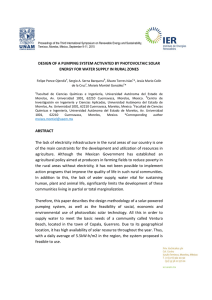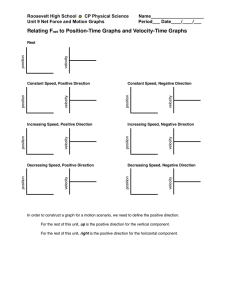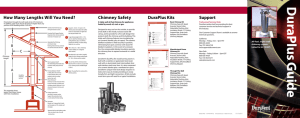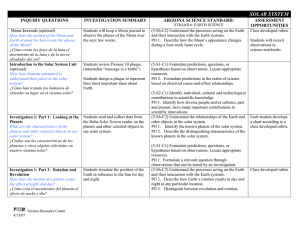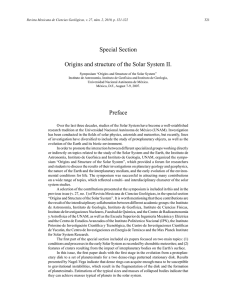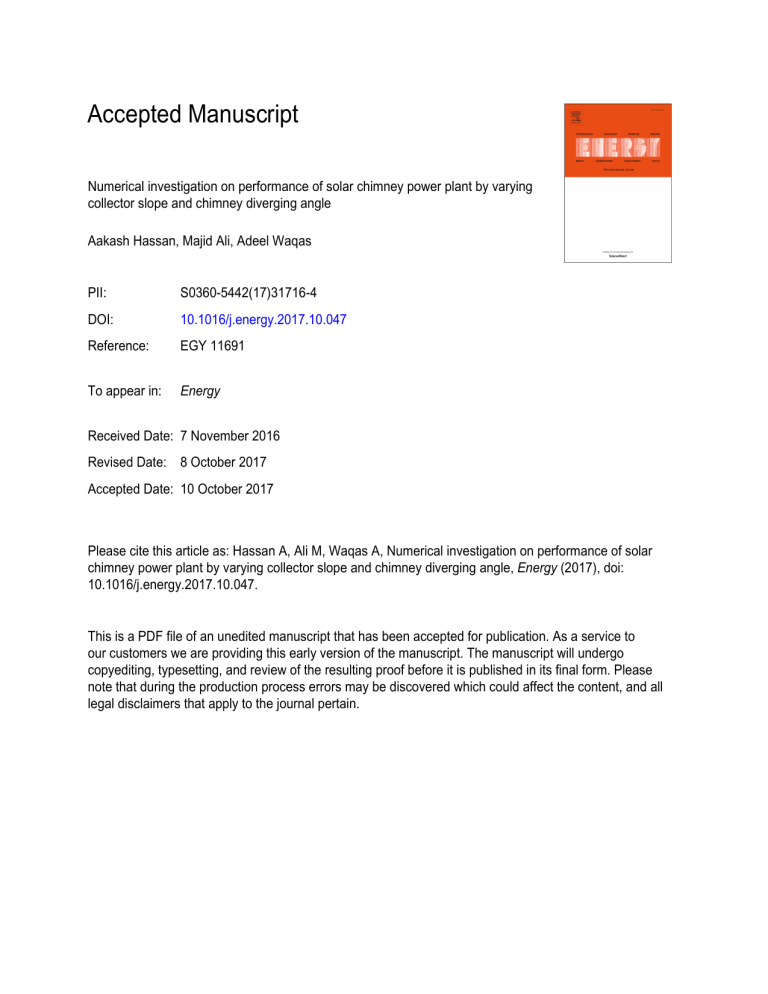
Accepted Manuscript Numerical investigation on performance of solar chimney power plant by varying collector slope and chimney diverging angle Aakash Hassan, Majid Ali, Adeel Waqas PII: S0360-5442(17)31716-4 DOI: 10.1016/j.energy.2017.10.047 Reference: EGY 11691 To appear in: Energy Received Date: 7 November 2016 Revised Date: 8 October 2017 Accepted Date: 10 October 2017 Please cite this article as: Hassan A, Ali M, Waqas A, Numerical investigation on performance of solar chimney power plant by varying collector slope and chimney diverging angle, Energy (2017), doi: 10.1016/j.energy.2017.10.047. This is a PDF file of an unedited manuscript that has been accepted for publication. As a service to our customers we are providing this early version of the manuscript. The manuscript will undergo copyediting, typesetting, and review of the resulting proof before it is published in its final form. Please note that during the production process errors may be discovered which could affect the content, and all legal disclaimers that apply to the journal pertain. ACCEPTED MANUSCRIPT 2 Numerical investigation on performance of solar chimney power plant by varying collector slope and chimney diverging angle 3 Aakash Hassan∗, Majid Ali, Adeel Waqas 4 5 6 7 8 9 U.S. Pakistan Center for Advanced Studies in Energy (USPCAS-E), National University of Sciences and Technology (NUST), H-12 Sector Islamabad, Pakistan RI PT 1 Email Addresses: [email protected]|[email protected], [email protected]|[email protected] Abstract In this study, a parametric three dimensional computational fluid dyamics (CFD) analysis of solar chimney power plant was performed to illustrate the effects of collector’s slope and chimney diverging angle on performance of Manzanares prototype. Numerical models were incorporated with solar load, DO (discrete ordinates) and RNG k-ɛ turbulence models. Firstly, CFD simulations results were validated by comparing them with the experimental data of Manzanares prototype and then, on the basis of robustness of numerical methods adopted, several numerical simulations were performed on varying collector’s slope and chimney diverging angles to improve the performance of solar chimney. Numerical simulations were performed at chimney diverging angle = 10-30 and at collector slope = 40, 60, 80 and 100 sequentially, while all other parameters were kept constant. Based on computed results, it was discovered that both velocity and temperature increases with increasing collector’s slope due to enhanced heat transfer and mass flow rate, but simultaneously higher collector slopes also deteriorate the smooth air flow by developing vortices and recirculation of air, which obstructs the air flow and may reduce the overall performance. In addition, chimney diverging angle =10 raises the velocity from 9.1 m/s to a remarkable value of 11.6 m/s; therefore, this diverging chimney approach is conceived to be a beneficial tool in improving performance of solar chimney power plant. 27 Keywords 28 Solar chimney power plant; Computational fluid dynamics; Collector slope; Diverging chimney 29 1. Introduction 30 31 32 33 34 35 Needless to say, energy plays a role of backbone for the socio-economic development of any country. Incessantly rising population and high living standards ask for endless energy resources to fulfill heightening energy demand. It is pragmatic that non-renewable energy resources (fossil fuels) are limited in nature and are being over utilized, so need to be restrained. Likewise, farreaching consumption of fossil fuels has polluted our environment severely, endangering life on our planet. This entire scenario necessitates the advancements in clean and sustainable energy AC C EP TE D M AN U SC 10 11 12 13 14 15 16 17 18 19 20 21 22 23 24 25 26 ∗ Correspondence information: Aakash Hassan, U.S. Pakistan Center for Advanced Studies in Energy (USPCAS-E), National University of Sciences and Technology (NUST) H-12 Sector Islamabad, Pakistan, +923002868138 1 ACCEPTED MANUSCRIPT production. Solar chimney power plant or solar updraft tower is a renewable type power generation technology, having a promising potential for large scale usage of solar energy. Its working principle is based upon three technologies named as, the chimney, collector and wind turbine. Solar radiations fall over the transparent collector heating the cold air beneath it, as hot air rises, chimney raised at the center of collector provides air an upthrust. This kinetic energy gained by air is used to run wind turbine generating electricity. This basic working principle of SCPP is illustrated in Fig.1. 43 44 45 46 47 48 49 50 51 52 53 54 55 56 57 58 59 The basic idea of producing electricity by combination of greenhouse effect and chimney was intimated by J. Schlaich. Later on, in 1983 J. Schlaich along with his team designed and constructed the first working solar chimney pilot plant in Manzanares, Spain. This prototype operated successfully for almost 8 years producing peak output of 50kW and constituted collector’s diameter of 240m, chimney’s height of 200m and a chimney’s diameter of 10m [1, 2]. Afterwards, the results obtained from Manzanares plant and fundamental governing equations for predicting the performance of SCPP were also reported. This unique idea of power generation attracted many scientists; consequently a lot of efforts were made to explore this technology. Y.J. Dai et al. evaluated the performance of solar chimney in Northwestern regions of China by developing a simplified mathematical model and proposed a solar chimney that could produce 110-190 kW monthly, supplying nearby villages in Northwestern regions of China [3]. K.S. Ong and C.C. Chow predicted the performance of solar chimney by solving steady state heat transfer equations using a thermal resistance network. The effect of different air gaps on the output were studied and mathematical model results were verified by setting up an experimental model [4]. Some investigators have also reported valuable comprehensive analytical models for predicting the performance of solar chimney power plant by taking into account the factors like friction loss, turbine loss and quality of soil, collector etc. [5–8]. 60 61 62 63 64 65 66 67 68 69 70 71 72 73 74 75 Accompanying the advancement in computer technology, the use of CFD softwares in studying the fluid flow and heat transfer has increased tremendously during the last decade due to its powerful visualization capabilities. Roozbeh Sangi et al. performed numerical simulations by iterative technique and predicted the performance of solar chimney through two dimensional axisymmetric modeling in CFD software FLUENT. The results of two approaches were compared ensuring good agreement [9]. Ehsan Gholamalizadeh and Man-Hoe Kim included the effects of heat transfer by radiations in the solar chimney by using two band radiation model and concluded that considering greenhouse effect is important for predicting the performance of solar chimney in an accurate manner [10]. The effects of geometric parameters on performance of small scale solar chimney were studied by Sandeep K. Patel et al. in ANSYS CFX. Results at different collector’s inlet and outlet diameters, chimney diameters and divergence angles were examined and the best configuration for solar chimney was suggested [11]. Ming Tingzhen performed numerical simulations on Spanish prototype solar chimney coupled with a three-blade turbine. The results indicated output power to be slightly greater than the experimental value; they also designed a MW graded solar chimney power plant [12]. Ehsan Shabahang Nia et al. numerically investigated the effects of three different passive flow control devices on heat AC C EP TE D M AN U SC RI PT 36 37 38 39 40 41 42 2 ACCEPTED MANUSCRIPT transfer and fluid flow inside solar chimney. The investigations revealed that flow control devices increase the heat transfer and velocity magnitude in solar chimney due to vortices developed by obstacles, resulting in better mixing of hot and cold air [13]. Penghua et al. conducted a three dimensional CFD analysis of solar chimney with a real turbine. It was found that fan model is also a convenient approach to predict the turbine performance in solar chimney; additionally the influence of sun zenith angle and turbine performance with rotational speed were also studied, and were found to be necessary in accurately predicting the performance of solar chimney [14]. Amir Rezaei Shahreza et al. developed a novel solar chimney which utilizes intensifiers to enhance the heat flux radiated by sun [15]. Recently, Ehsan Gholamalizadeh and Man Hoe Kim performed a CFD analysis of solar chimney with an inclined collector by increasing the distance between ground and chimney base concluding that, inclined collector enhances the mass flow rate in system [16]. 88 89 90 91 92 93 94 95 96 97 98 Although worthful contributions were made to analyze performance and develop more insight of SCPP but, most of them studied similar parameters of SCPP such as: height of chimney, turbine pressure drop, diameter of collector and heat storage medium beneath collector. In order to accurately design and improve performance of SCPP, the other parameters like collector slope and converging-diverging angles of chimney must also be considered. Recently, only initial level investigations were conducted on aforementioned parameters. Moreover, previously SCPP was mostly modeled as a 2D (two dimensional) axisymmetric model. Generally, 2D model doesn’t give us a detailed picture of heat transfer and fluid flow patterns inside the whole system. Hence, in the present study a three dimensional CFD analysis incorporating solar load, Discrete Ordinates (DO) and RNG k-ɛ turbulence model at different collector slopes and chimney diverging angles for Spanish prototype SCPP was performed. 99 Nomenclature J Ra g L EP area (m2) specific heat (J/kg K) energy (J) solar intensity (W/m2) temperature (K) AC C A Cp E I T TE D M AN U SC RI PT 76 77 78 79 80 81 82 83 84 85 86 87 diffusion flux (kg/ m2s) Rayleigh number gravitational acceleration (m/s2) length scale (m) effective viscosity Greek symbols α air velocity (m/s) β Poutput power output (W) t time (s) n refractive index ε µ ρ v turbulence kinetic energy due to buoyancy source term in momentum equation heat source in energy equation effective conductivity collector’s slope, thermal diffusivity (m2/s) chimney diverging angle, thermal expansion coefficient (K-1) turbulent dissipation rate (m2/s3) dynamic viscosity (Pa s) density (kg/m3) 3 ACCEPTED MANUSCRIPT ̿ λ overall velocity (m/s) position vector direction vector scattering direction vector external body force turbulence kinetic energy due to mean velocity gradient contribution of fluctuating dilation in compressible turbulence to overall dissipation rate Subscripts i,j solid angle (radians) phase function scattering coefficient (m-1) Stefan Boltzmann constant (5.67x 10-8 W/m2 K4) stress tensor (Pa) thermal conductivity(W/m-K) RI PT ′ ` ∅ directional components SC pressure (Pa) kinetic energy (J/Kg) heat transfer coefficient (W/m2-k) axial coordinate (m) M AN U p k ℎ 100 2. 102 2.1 Case study description 103 104 105 106 107 108 109 110 111 112 113 114 115 116 To investigate the effects of varying collector’s slope and chimney diverging angles on performance of SCPP, Manzanares power plant was considered as a base case and a parametric analysis was performed by using CFD technique. CFD software ANSYS FLUENT was used for detailed analysis of heat transfer mechanisms and fluid dynamics involved in SCPP. It was reported that in Manzanares prototype, to divert the air flow in chimney, height of collector was raised gradually from 1.85m up to 6m adjacent to the chimney base and turbine was installed near chimney base on a framework 9m above ground level. Furthermore, a cylindrical shaped chimney made from thick trapezoid sheets reinforced with rings without any diffuser was employed in Manzanares plant[1]. The dimensions of this prototype plant along with other parameters which were used in simulating reference Manzanares case are given in Table1 and parameters investigated in this study viz. collector slope α and chimney diverging angle β are presented in Fig.1. After validation of CFD simulation results of Manzanares case, further numerical simulations were performed at α (collector slope) = 40, 60, 80, 100 and at β (diverging angle) = 10-30 sequentially to examine their effects on performance of SCPP. 117 2.2 118 119 120 The main governing equations used in modelling SCPP are based on the fundamental mass, momentum and energy conservation equations described below: The mass conservation or continuity equation can be written as [17]: 121 Methodology AC C EP TE D 101 Mathematical Formulation + ∇. = (1) 4 ACCEPTED MANUSCRIPT Where is the user defined source term or mass added to the continuous phase from dispersed second phase. In our case the flow is incompressible without any source term, so the above equation can be simplified as: ∇. = 0 and in Cartesian coordinate system it can be expressed as: ( ) * + + =0 (2) Momentum conservation equation is stated as: 129 130 131 132 133 + + ∇. = −∇- + ∇. ̿ + . + (3) Where - in the above equation is the static pressure, ̿ is stress tensor, . and are the gravitational body force and external body forces respectively. In rectangular coordinate systems for an incompressible flow, eq. (3) can be expanded as: &0 134 / + 1' 135 / + 1' 136 / &5 &6 + 1' &0 ' + 1) &0 &0 &5 ) + 1+ ' + 1) &5 ) + 1+ &5 &6 + 1) &6 + 1+ &6 ' ) + 2 = -/ + 2 = -/ SC 127 128 ' RI PT & 126 30,0 ' + 35,0 + 35,5 ) + 36,0 + 2− + .' (4) ) + 36,5 + 2 − ) + .) (5) M AN U 122 123 124 125 + 30,5 2 = -/ ' 30,6 ' + 35,6 ) + 36,6 + 7 ' 7 2− 7 + + .+ (6) In our case, to model buoyancy driven flow, gravitational acceleration was activated in negative y-direction. Therefore, the terms .' and .+ can be omitted from equations 4 and 6 respectively. 141 2.2.1 Turbulence modeling 142 143 In SCPP air flow is induced due to density variations caused by heat addition. The strength of such buoyancy driven flows is calculated by Rayleigh number (Ra). TE D 137 138 139 140 89 = 151 152 (7) AB Flow is fully turbulent if 89 > 10 . Previous studies show that flow in SCPP is turbulent with 89 > 1010 [10]. Consequently, to model turbulence in flow, Renormalization group (RNG) k-ɛ model was used owing to its better reliability and accuracy to solve a wider class of flows. The transport equations of (RNG) k-ɛ model are given by [17]: 149 150 :;∆=>? @ 10 AC C 145 146 147 148 EP 144 + I + I ' C 'C = D = D 'E 'E FGJ FG ' H E J ' H E + + − I − + J + KLJ + KMJ − KNJ JO − 8J + J (8) (9) For incompressible flows above equations can be simplified as: + ' C D = 'E FG ' H E + + − I − + (10) 5 ACCEPTED MANUSCRIPT 158 159 160 161 162 163 164 165 C D = 'E FGJ J ' H E J + KLJ + KMJ − KNJ JO − 8J + J (11) Where 9PQ represent the generation of turbulence kinetic energy due to mean velocity gradient and buoyancy respectively. 9PQ J are user defined source terms and G , GJ stand for inverse effective Prandtl numbers for k and ɛ respectively. may be defined as: = AE A @ −TTTTTTTT and for ideal gases = −.D U , where W is turbulent Prandtl number for R′ S′ 'C @7VU 'C RI PT 157 + ' I energy and .D is the component of gravitational vector in Xth direction. The effect of buoyancy ( on I is determined by KMJ , which can be calculated as: KMJ = Y9Pℎ Z&Z where is the component of flow velocity parallel to gravitational vector and 1 is the component of flow velocity perpendicular to gravitational vector. The main difference between RNG and Standard k-ɛ model lies in the additional term 8J given by: 8J = ^ ^_ L` ;] ? ∁\ @] ? L ɛO , where c ≡ /ɛ, cf = 4.38, ∁A = SC 154 155 156 J b 0.0845 9PQ k = 0.012. Moreover, the model constants KLJ and KNJ in eq. (11) are derived analytically from RNG theory having values 1.42 and 1.68 respectively. M AN U 153 2.2.2 Modeling Heat transfer 167 168 169 170 171 172 In modeling a solar chimney power plant, we have to consider all three modes of heat transfer i.e. conduction, convection and radiation. The radiation effects of sun rays entering in computational domain were calculated by solar load model using Solar Ray Tracing algorithm. Ray tracing computes the heat flux resulting from incident solar radiations and results are coupled to ANSYS FLUENT calculations via a source term in energy equation. FLUENT solves energy equation in the following form [17]: n + ∇. on p = ∇. /o ∇q − ∑s ℎs ts p + o̿ . p2 + (12) 176 177 178 179 180 181 182 183 184 185 186 187 188 The first three terms on right hand side in the above equation, represent energy transfer due to conduction, species diffusion and viscous dissipation. indicates volumetric heat sources that user has defined. is the effective conductivity and ts is the diffusion flux of species j. As EP 174 175 our flow is incompressible and there are no diffusion terms, eq. (12) can be simplified as: ∇. on p = ∇. ∇q + ̿ . + (13) Heat transfer through radiations was computed by applying the discrete ordinates (DO) model, because of the fact that DO model has the ability to solve radiations through semitransparent walls and a wide range of optical thicknesses [17]. The radiative transfer equation for “DO” model is: zx v= w v Q ′ ∇. u , + 9 + u , = 9PN + y { u /, ′2 ∅, ′ (14) AC C 173 TE D 166 x zx f Where I is solar intensity, and represent position vector and direction vector respectively. T denotes the local temperature and ′ is scattering direction vector. Where ∅ and ′ represent phase function and solid angle respectively. Further detail about these models can be found in [17]. 6 ACCEPTED MANUSCRIPT 2.3 Computational domain, boundary conditions and solution methodsModel of 190 191 192 193 SCPP was created in ANSYS Design Modeler by using structural dimensions of first working model of SCPP built in Manzanares Spain given in Table1. To reduce the computational efforts, the entire domain was divided into half by 1800 revolve. Three dimensional model of SCPP exhibiting different zones is presented in Fig.2. 194 195 196 197 Computational domain of solar chimney power plant was discretized into hexahedral mesh by ANSYS ICEM CFD. To achieve most favorable mesh size, a grid independence study was performed on five different mesh sizes by judging maximum temperature and velocity as depicted in Table2. 198 199 200 It can be concluded from the Table2 that, temperature and velocity almost remains invariable after Grid 3. Therefore, Grid 3 was chosen for all simulations as further mesh refinement will only increase run time. 201 202 The main boundary conditions specified for numerical simulations are depicted in Fig.2 and their details are given below: 203 204 205 206 207 208 209 210 Sun direction vector was computed from solar calculator by specifying the North, East direction vectors along Y-axis and X-axis respectively. Similarly, solar irradiation value was calculated from solar calculator by specifying global position of Manzanares mentioned in Table1. A typical day of June and day time of 1:00 p.m. was selected for numerical simulations. Although, atmosphere is not uniform and air properties vary with altitude away from earth surface, but for smaller altitude as in Manzanares case with chimney height =195m, the air properties can be assumed to be constant. Thus, in this study values of air properties close to ground were used. Operating pressure of 1atm and environmental temperature of 303K were selected. 211 212 213 214 215 216 217 218 219 220 221 222 223 224 225 226 227 Collector inlet is set as pressure-inlet boundary and chimney outlet is set as pressure-outlet boundary condition. Adopting previous researches, inlet and outlet pressure were set at 0 Pa, because in modeling natural convection problems, there should be no pressure difference between inlet and outlet [10,13,19,20]. Total temperature = 303K was defined for pressure inlet and pressure outlet boundary condition, which is assumed to be equal to static temperature when flow is incompressible. An average operating density of air = 1.164 kg/m3 was specified in fluid domain. Flow direction was specified as “normal to boundary” in direction specification method and absolute reference frame was selected. K and Epsilon method was chosen to compute the turbulence parameters. Collector roof was considered to be made up of glass having transmissivity = 0.8, Cp = 840(J/kg-K), ρ = 2700(kg/m3) and λ = 0.78 (W/m-K)[10]. As glass retains infra-red radiations but allows visible radiations to pass through it, therefore glass absorptivity and transmissivity for visible radiations was set to 0.04 and 0.92 respectively in solar boundary conditions. Similarly, glass absorptivity and transmissivity for infra-red radiations were assigned value of 0.95 and 0.05 respectively. Collector was modeled as a semitransparent wall with mixed boundary condition which accounts for heat transfer by both convection and solar irradiance. Soil was selected as a ground material having properties as follows: Cp = 2200(J/kg-K), ρ = 1900(kg/m3) and λ = 1.83 (W/m-K) [10]. Ground was modeled as AC C EP TE D M AN U SC RI PT 189 7 ACCEPTED MANUSCRIPT an opaque wall with mixed boundary condition to model the heat transfer by convection and long wavelength radiations. Moreover, chimney was considered as an adiabatic wall and symmetry boundary condition was assigned to center halved zone. These boundary conditions were adopted for all the cases of sloped collector and diverging chimney. 232 233 234 235 236 237 238 All simulations were performed by assuming steady state condition. Air was treated as an ideal gas and SIMPLE algorithm was selected as the pressure-velocity coupling scheme. In order to find accurate results, second order accuracy was selected for all variables. Solution was run up to 2000 iterations to ensure that solution is converged and all residual values reach convergence criteria. Convergence was also assured by monitoring convergence history of mass flow rate at outlet shown in Fig. 3, which shows that mass flow rate has stabilized and ensures solution has converged. 239 3. Results and Discussion 240 3.1 241 242 243 244 245 246 247 248 249 250 251 252 253 254 255 256 257 258 259 260 To verify the applicability of numerical models adopted in predicting SCPP performance, CFD simulation results of base case with geometric parameters of Manzanares prototype were compared with the reported experimental results. Velocity and static temperature contours along symmetry for base case are presented in Fig.4 and Fig.5 respectively. Fig.4 depicts that velocity of air increases slowly along the collector’s length but escalates sharply to 9.16 m/s at the chimney base; owing to the maximum velocity achieved, chimney base can be considered as a suitable location for turbine installation. It can also be observed from Fig.5 that, temperature of air rises along the collector’s length due to falling solar radiations and then almost remains constant along the chimney because, almost negligible heat transfer takes place through the chimney walls. Temperature of ground is much higher as compared to collector and reaches up to 318K. This higher temperature of ground is due to the greenhouse effect and high specific heat of ground. These results demonstrate that SCPP can work at night as well since, ground acts as a natural heat storage layer capturing heat from solar radiations during day time and then releasing it later at night. In Manzanares prototype, air velocity equal to 9m/s and temperature rise of 17-19K were reported [2]. In CFD simulations at chimney inlet, air velocity = 9.1m/s and temperature rise of 15K beneath collector is predicted. Hence, CFD simulations results are found to be within acceptable range of experimental results, which ensures the correctness of numerical models adopted in predicting the SCPP performance. 261 3.2 262 263 264 To analyze the effects of varying collector’s slope on flow distribution of air inside SCPP, velocity streamlines starting from inlet at different collector slopes are presented in Fig.6 (a-d). M AN U AC C EP TE D Validation of base case SC RI PT 228 229 230 231 Effects of collector’s slope variations on SCPP performance 8 ACCEPTED MANUSCRIPT It can be observed from the Fig.6 that velocity magnitude increases with an increase in collector slope reaching 9.05m/s, 9.34m/s, 9.46m/s and 9.75m/s at 40,60,80 and 100 collector slopes respectively. But simultaneously, it can also be noticed that air flow remains smooth and uniform until slope = 60 but at higher slopes = 80 and 100, vortices and recirculation of air is detected beneath collector which obstruct the air flow and may bring down the overall performance. The reason can be traced down in the fact that as the gap between ground and collector is enhanced; the gravitational and buoyancy forces become strong and impose diverse manipulation on the air flow. Fig.7 and Fig.8 evidently reveal the causes of afore mentioned behavior. Fig.7 depicts the variations of ground surface temperature at different collector’s slopes. 289 290 291 292 So, it can be inferred that at collector’s slope greater than 60, recirculation of air starts developing beneath the collector due to density gradients formed by uneven distribution of temperature. This may cause obstruction of air flow within the chimney and deteriorate the performance of wind turbine. 293 3.3 294 295 296 297 298 299 300 301 302 303 Broadly speaking, SCPP can be viewed as a converging diverging nozzle. Collector inlet to chimney inlet portion can be regarded as converging portion because; air gets converged into chimney due to buoyancy effect. Similarly, chimney base can be regarded as throat and upper portion of chimney can be conceived as diverging section. So, a careful design of SCPP can deliberately enhance the performance of SCPP. Usually, the converging diverging nozzles are utilized in applications like rocket engines in which chemical thermal energy generated in combustion chamber is converted into kinetic energy and supersonic speed has to be achieved. But in SCPP there is no such source and requirements as those required in rockets. Manzanares base case can be regarded as a straight chimney having diverging angle (β) = 00. Therefore, to illuminate the effects of considering SCPP as a nozzle, initial investigations were performed by RI PT 265 266 267 268 269 270 271 272 273 274 275 276 277 278 279 280 281 282 283 284 285 286 287 288 EP TE D M AN U SC It can be observed from Fig.7 that ground temperature rises with increasing collector’s slope, which is due to fact that inclined collector can receive more solar radiations as compared to flat collector resulting in enhanced heat transfer. Moreover, due to tilted collector some parts of collector now receives greater amount of solar radiations causing uneven distribution of temperature. Fig.8 shows the density contours plot against velocity vectors over symmetry plane for α =100. It indicates that at higher collector’s slope, density gradients are developed beneath the collector due to uneven distribution of temperature which stimulates the recirculation of air. The reason behind the increment in velocity with slope is that, in modeling buoyancy driven flows inside a closed domain, the solution depends upon the mass conserved inside [17]. When collector’s slope is increased the mass of air confined in it increases as well, resulting in enhanced mass flow rate as depicted in Fig.9. Another reason is the better mixing of air due to turbulence effects, resulting in enhanced heat transfer. As in SCPP, main driving force is the temperature difference of air beneath collector and ambient air, therefore an increment in velocity is observed with increase in collector’s slope but at the expense of flow uniformity. AC C Effects of diverging chimney on performance of SCPP 9 ACCEPTED MANUSCRIPT 304 305 varying chimney diverging angles (β) = 10-30 while keeping all other parameters same as Manzanares case. 306 In SCPP, power available from turbine can be expressed as [20]: Poutput = 0.5 ρAv3 307 (8) Above expression shows that power is directly proportional to velocity cube and area swept by turbine. In SCPP, turbine is considered as shrouded turbine whose area depends upon the chimney area. So, if chimney area is reduced we’ll also have to reduce the turbine area accordingly, which will bring down the overall power output. So, chimney design requires very precise calculations for optimum power output. 313 314 315 316 317 318 The distribution of velocity for three different chimney’s diverging angles 10, 20 and 30 is evaluated in Fig.10 (a-c); the chimney inlet area and all other parameters were kept constant except the chimney outlet area. The results show that employing a diverging chimney leads to remarkable increase in velocity. Maximum velocity of 11.6m/s is achieved for case when diverging angle is 10, while it reaches 11.3m/s and 10.3m/s for diverging angles of 20 and 30 respectively. 319 320 321 322 323 Fig.11 illustrates the static pressure variations along chimney length at different diverging angles of chimney. It can be observed that static pressure drops dramatically at the chimney base due to eminent air flow. Furthermore, it can also be noticed that when diverging chimney is used, static pressure at chimney base drops significantly in accord with Bernoulli’s principle and reaches a minimum value of -75 Pa when chimney diverging angle =10. 324 325 326 327 328 329 330 331 332 Likewise, Fig. 12 shows variations of dynamic pressure at different diverging angles of chimney. It indicates that in case of Manzanares prototype plant with straight chimney, a maximum dynamic pressure of 46 Pa is achieved near chimney base, which drops slowly and reaches 25 Pa along the chimney. While in the case when a diverging chimney is employed, dynamic pressure increases significantly at chimney base and then falls abruptly due to expansion of area. A maximum dynamic pressure of 75 Pa is achieved in case when diverging angle = 10. This pressure gradient created due to diverging chimney assists in higher air intake and thus a large amount of electricity can be generated from pressure energy of air by installing a properly designed pressure staged turbine. 333 334 335 336 337 In order to clearly visualize the effects of chimney diverging angles on air flow inside the whole system, the velocity streamlines starting from inlet are shown in Fig. 13(a-c). Results show that at diverging angle β =10, flow remains smooth and uniform but at higher diverging angles of 20 and 30 velocity of air drops drastically after passing through chimney base due to diverging section and flow separation is detected. 338 339 Finally, the power output for four cases is plotted in Fig.14 and corresponding power increment is presented in Table 3. As expected, owing to the maximum velocity, power output is highest AC C EP TE D M AN U SC RI PT 308 309 310 311 312 10 ACCEPTED MANUSCRIPT for case β = 10 with remarkable percentage increment of 108%. As power from turbine is directly related to cube of velocity, a small increment in velocity results in a tremendous increase in power. 343 344 345 346 Although it was shown that, diverging chimney improves the system performance but, from constructional point of view, building up a diverging chimney would require special expertise and may increase the cost of SCPP. 347 4. 348 349 350 351 352 353 354 355 356 357 358 359 360 361 362 363 364 In this study effects of collector’s slope and diverging chimney on performance of SCPP are numerically investigated. The scope of this study comprises the validation of CFD simulations performed on Manzanares prototype with reported experimental results. The validated CFD approach incorporating RNG k-ɛ, solar load, DO radiation model is then used to investigate the effects of different collector’s slopes and chimney diverging angles on air flow and heat transfer in SCPP, aiming to improve its performance. Numerical results show that by increasing collector’s slope there is a gradual increase in air velocity. But at collector slopes higher than 60, air flow does not remain uniform and recirculation of air, vortices are detected beneath the collector due to density gradients formed by uneven distribution of temperature, which may obstruct the air from entering inside chimney and thus may reduce the overall performance of SCPP. Likewise, the effects of diverging chimney on performance of SCPP were also investigated at diverging angles (β) =10-30. Results show that employing a chimney diverging angle =10 results in a noteworthy increment in velocity form 9.1m/s to 11.6m/s which is estimated to increase the power output by 108%. Therefore, as compared to other approaches of increasing the performance of SCPP like increasing height of chimney and collector diameter, by employing diverging chimney we can achieve high power output at much smaller chimney height and collector diameter. 365 Acknowledgements 366 367 368 The authors express acknowledgements to the faculty of U. S. Pakistan Centre for Advanced Studies in Energy (USPCAS-E) NUST Pakistan, who made their valuable contributions and supported this study. RI PT 340 341 342 AC C EP TE D M AN U SC Conclusions 369 370 References 371 372 [1] W. Haaf, K. Friedrich, G. Mayr, and J. Schlaich, “Solar Chimneys Part I : Principle and Construction of the Pilot Plant in Manzanares,” no. August 2013, pp. 37–41, 2007. 373 374 [2] W. Haaf, “Solar Chimneys Part II: Preliminary Test Results from the Manzanares Pilot Plant,” Int. J. Sol. Energy, vol. 2, pp. 141–161, 2007. 375 [3] Y. . Dai, H. . Huang, and R. . Wang, “Case study of solar chimney power plants in 11 ACCEPTED MANUSCRIPT Northwestern regions of China,” Renew. Energy, vol. 28, no. 8, pp. 1295–1304, Jul. 2003. 376 [4] K. S. Ong and C. C. Chow, “P erformance of a solar chimney,” vol. 74, pp. 1–17, 2003. 378 379 [5] M. a. dos S. Bernardes, a. Voß, and G. Weinrebe, “Thermal and technical analyses of solar chimneys,” Sol. Energy, vol. 75, no. 6, pp. 511–524, Dec. 2003. 380 381 [6] J. P. Pretorius and D. G. Kröger, “Critical evaluation of solar chimney power plant performance,” Sol. Energy, vol. 80, no. 5, pp. 535–544, May 2006. 382 383 [7] A. J. Gannon and T. W. Von Backstro, “With System Loss and Solar,” vol. 122, no. August, pp. 133–137, 2000. 384 385 [8] M. M. Padki and S. A. Sherif, “On a simple analytical model for solar chimneys,” vol. 349, no. June 1998, pp. 345–349, 1999. 386 387 [9] R. Sangi, M. Amidpour, and B. Hosseinizadeh, “Modeling and numerical simulation of solar chimney power plants,” Sol. Energy, vol. 85, no. 5, pp. 829–838, May 2011. 388 389 390 [10] E. Gholamalizadeh and M.-H. Kim, “Three-dimensional CFD analysis for simulating the greenhouse effect in solar chimney power plants using a two-band radiation model,” Renew. Energy, vol. 63, pp. 498–506, Mar. 2014. 391 392 393 [11] S. K. Patel, D. Prasad, and M. R. Ahmed, “Computational studies on the effect of geometric parameters on the performance of a solar chimney power plant,” Energy Convers. Manag., vol. 77, pp. 424–431, Jan. 2014. 394 395 396 [12] M. Tingzhen, L. Wei, X. Guoling, X. Yanbin, G. Xuhu, and P. Yuan, “Numerical simulation of the solar chimney power plant systems coupled with turbine,” Renew. Energy, vol. 33, no. 5, pp. 897–905, May 2008. 397 398 399 [13] E. S. Nia and M. Ghazikhani, “Numerical investigation on heat transfer characteristics amelioration of a solar chimney power plant through passive flow control approach,” Energy Convers. Manag., vol. 105, pp. 588–595, Nov. 2015. 400 401 [14] P. Guo, J. Li, Y. Wang, and Y. Wang, “Numerical study on the performance of a solar chimney power plant,” Energy Convers. Manag., vol. 105, pp. 197–205, Nov. 2015. 402 403 [15] A. R. Shahreza and H. Imani, “Experimental and numerical investigation on an innovative solar chimney,” Energy Convers. Manag., vol. 95, pp. 446–452, May 2015. 404 405 406 [16] E. Gholamalizadeh and M.-H. Kim, “CFD (computational fluid dynamics) analysis of a solar-chimney power plant with inclined collector roof,” Energy, vol. 107, pp. 661–667, Jul. 2016. 407 [17] 408 [18] 409 410 [19] 411 412 [20] AC C EP TE D M AN U SC RI PT 377 “ANSYS FLUENT Theory Guide,” vol. 15317, no. November, pp. 724–746, 2011. T. D. Canonsburg, ANSYS FLUENT User â€TM s Guide, vol. 15317, no. November. 2011. P. Guo, J. Li, and Y. Wang, “Numerical simulations of solar chimney power plant with radiation model,” Renew. Energy, vol. 62, pp. 24–30, Feb. 2014. A. Rezaei and H. Imani, “Experimental and numerical investigation on an innovative solar chimney,” Energy Convers. Manag., vol. 95, pp. 446–452, 2015. 413 414 415 12 ACCEPTED MANUSCRIPT 416 417 418 RI PT 419 420 421 422 SC 423 424 M AN U 425 426 427 428 432 433 434 435 436 437 EP 431 AC C 430 TE D 429 438 439 440 441 13 ACCEPTED MANUSCRIPT Figures with captions M AN U SC RI PT 442 443 Fig.1- Schematic diagram of SCPP 444 445 AC C EP TE D 446 447 448 Fig.2- Computational domain of SCPP with different zones 449 14 ACCEPTED MANUSCRIPT M AN U SC RI PT 450 451 452 Fig. 3- Convergence history of mass flow rate at outlet 454 455 AC C EP TE D 453 Fig.4- Base case-velocity contours along symmetry 15 M AN U SC RI PT ACCEPTED MANUSCRIPT 456 457 Fig.5- Base case-temperature contours along symmetry 458 AC C EP TE D 459 460 461 462 Fig.6 (a) - Velocity streamlines at α =40 463 16 ACCEPTED MANUSCRIPT M AN U SC RI PT 464 465 Fig.6 (b) - Velocity streamlines at α =60 467 468 AC C EP TE D 466 Fig.6 (c) - Velocity streamlines at α =80 17 M AN U SC RI PT ACCEPTED MANUSCRIPT 469 Fig.6 (d) - Velocity streamlines at α =100 470 471 472 AC C EP TE D 473 474 475 Fig.7- Temperature of ground at varying collector slopes 18 ACCEPTED MANUSCRIPT M AN U SC RI PT 476 477 Fig.8- Effects of density variations on air flow 478 479 290 280 275 270 265 260 AC C Mass flow rate(kg/s) 285 EP 295 TE D 480 255 250 245 240 Manzanares 481 482 slope=4° slope=6° slope=8° slope=10° Fig.9- Computed mass flow rates at different collector slopes 483 19 M AN U SC RI PT ACCEPTED MANUSCRIPT 484 Fig.10 (a) – Distribution of velocity at β =10 485 AC C EP TE D 486 487 488 Fig.10 (b) – Distribution of velocity at β= 20 489 20 M AN U SC RI PT ACCEPTED MANUSCRIPT 490 Fig.10 (c) – Distribution of velocity at β= 30 491 493 494 AC C EP TE D 492 Fig.11- Static pressure at different diverging angles 21 M AN U SC RI PT ACCEPTED MANUSCRIPT 495 Fig.12- Dynamic pressure at different diverging angles 497 498 AC C EP TE D 496 Fig.13 (a) - Velocity streamlines inside SCPP at β= 10 499 22 M AN U SC RI PT ACCEPTED MANUSCRIPT 500 Fig.13 (b) - Velocity streamlines inside SCPP at β= 20 502 503 AC C EP TE D 501 Fig.13 (c) - Velocity streamlines inside SCPP at β = 30 504 23 ACCEPTED MANUSCRIPT 505 80 506 70 50 RI PT Power (kW) 60 40 30 10 0 Manzanares 508 510 516 517 518 519 520 EP 515 AC C 514 TE D 511 513 β=3° Fig.14- Effect of diverging chimney on power output 509 512 β=2° M AN U 507 β=1° SC 20 521 522 24 ACCEPTED MANUSCRIPT Tables 523 524 525 Table 1- Dimensions and parameters used in predicting performance of SCPP Value 38.990 N RI PT Parameters Latitude of Manzanares, Spain 3.370 W Longitude of Manzanares, Spain GMT of Manzanares, Spain +2 Height of chimney 195 m 122 m SC Radius of collector Radius of Chimeny 5m 2m M AN U Collector inlet to ground distance Distance of Chimney base from Ground 526 527 Table 2- Grid Independence Study 531 Grid Name Maximum velocity(m/s) 1 Grid 1 66619 45.009 8.510 2 Grid 2 114636 45.427 8.638 3 Grid 3 163496 45.28 9.163 4 Grid 4 208024 44.931 9.104 5 346862 44.868 9.108 Cells Count TE D S. No Grid 5 AC C 530 Maximum Temperature(C) EP 528 529 6m Table 3- Maximum velocity magnitudes at different chimney diverging angles Case Description Maximum Velocity (m/s) Percentage increase in Power (%) Manzanares (β= 00) 9.1 0 β= 10 11.6 108% β= 20 11.3 90% β= 30 10.3 46% 532 25 ACCEPTED MANUSCRIPT Highlights EP TE D M AN U SC RI PT CFD analysis of solar chimney power plant is presented. Effects of sloped collector and diverging chimney are analyzed. Above optimum collector slope, vortices develop and performance deteriorates. Employing diverging chimney causes tremendous increase in updraft velocity. AC C • • • •


